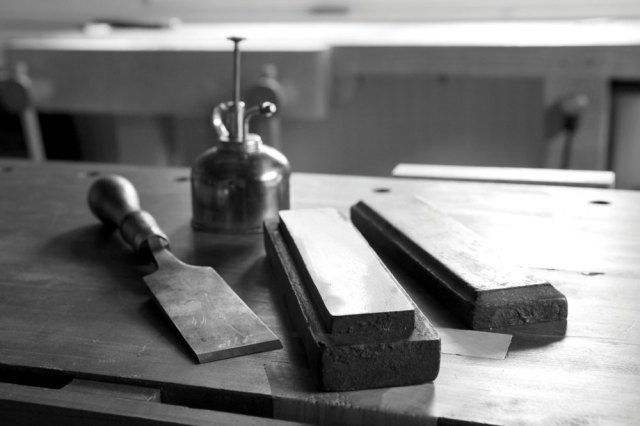
Anyone who has heard me talk about sharpening knows that I don’t really give a rodent’s hinder what system you select. Just pick one and stick with it. Just please don’t sample all the systems — that will definitely slow your efforts to get a keen edge.
Despite my “I’m OK, you’re OK philosophy,” I have a few beefs with some sharpening systems. Sandpaper is crazy expensive in the long run. Water-cooled grinders are crazy slow in the long walk, short run or whatever. I can say this because I’ve had to learn and use all the systems on the market, including LapSharp, Jool Tool, WorkSharp, etc. etc.
When I worked at Popular Woodworking Magazine, I used Shapton waterstones almost exclusively. Why? Because they cut faster than any system I’ve used, and they don’t need to be soaked. They do have downsides. They are sloppy, like all waterstones. You need a dedicated place to sharpen or you have to be one of those woodworkers who is, um, let’s just say “fastidious.” And they are expensive. I can say this because I have burned through several stones from several manufacturers.
When I left Popular Woodworking Magazine, I moved all my woodworking equipment to my shop at home. This shop is a lot smaller. There is no easy access to water. The floor is oak instead of hateful concrete. I don’t have room for a dedicated sharpening station.
So I switched back to oilstones for sharpening.
When I first learned sharpening, I had an India combination stone and a nice black Arkansas that a friend picked up for me at a gun meet. And a strop. That was plenty of equipment to get a keen edge.
But as I became the person who had to sharpen lots and lots of tools for the shop and for all our tool testing, I needed a system that was faster. We had the space for a dedicated sharpening area, so I dove into waterstones.
Today I have had to go back to my roots. I need to be able to sharpen on my bench. I need to do it without slopping water all over my benchtop and work pieces. And the system needs to be fast, but seconds don’t count anymore.
So I switched back to natural oilstones. When I was on the hunt for some, I bought a couple nice vintage ones. But then I had a chat with Larry Williams at Old Street Tool (formerly Clark & Williams planemakers) in Eureka Springs, Ark. He had been down to visit two places that mined and sold natural oilstones. He was quite pleased with the stones he picked up, and he’s now working on an article about the stones.
The two places Larry visited are Best Sharpening Stones and Dan’s Whetstone Co. (Correction: Larry informs me they visited Dan’s, but not Best, which is in New Jersey. My mistake.) Both carry a full range of natural and beautiful novaculite stones in any size you could want. Natural oilstones cut plenty fast for the home woodworker and make a nice keen edge.
So should you follow suit and switch to oilstones?
No. Stick with the system you are exploring right now. But if you haven’t chosen a system, don’t let the sharpening snobs talk you out of trying oilstones. They are tremendous.
So that is why I recently switched to oilstones. I sold one of my set of Shaptons. I’ll probably hold onto the other for when I teach classes, or until the day comes when I have a dedicated sharpening area in my shop.
— Christopher Schwarz